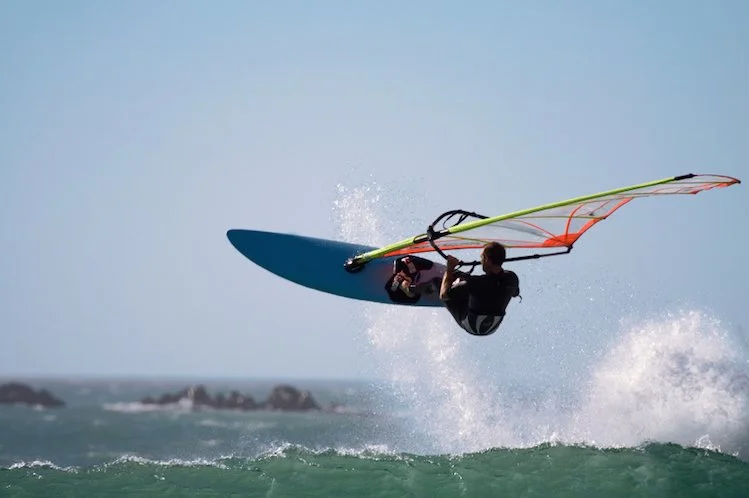Boardsailing is sometimes called windsurfing or sailboarding.
The boardsailor stands on the sailboard that looks like a surfboard with a sail on it.
The boardsailor uses his or her body to steer the sailboard along, catching the wind to fill the sail and push the board along.
A boardsailor's gear is called the 'complete rig'.
The board, the mast, the sail and the boom are the 'parts of the rig' and when all the parts of the rig are assembled, it is called a 'complete rig'.
A boardsailor catching the wind and becoming temporarily airborne. Image©Getty
Boards can be from about 2 to 4 metres long. Beginning boardsailors use a board about 3 metres long. Some boards have padded footstraps on the top of the back end of the board that the boardsailor tucks his or her toes under to get a good grip of the board. These footstraps can also be used as handles to carry the board.
Masts are about 5 metres long and are made of aluminum or fiberglass or carbon composites. They are made to be lightweight and able to bend.
Booms are the U-shaped handles that are clamped to the mast and go around both sides of the sail. They are made from aluminum or from a material called a carbon composite.
Sails are made of sheets of Dacron or other plastic-type fabrics. They have fibre glass sticks called 'battens' to help keep the sail's shape. Sails come in different sizes from 3 to 6 square metres. Boardsailors usually have different sized sails and choose the one to use depending on the speed of the wind. Sails come in different shapes too. The shape chosen depends on the type of boardsailing the person is going to try. Wave sails are for boardsailing on waves, slalom sails are for speed sailing on flat water, and sails known as convertible sails can be used for both kinds of sailing.
Boardsailors catch the wind and sails across the waves. © Getty Images
A sailboard also has fins, a mast base and an uphaul.
Fins are fitted underneath of the board and help with speed. Fins are sometimes called skegs. The mast base is where the mast fits to the board. The uphaul is a length of thick rope that is attached to the boom near the mast and to the mast base. The uphaul is used to lift the sail out of the water.
Getting into the water.
The boardsailor carries the sail out into shallow water first. The sail is left in the water while the boardsailor gets the board and carries it out to the sail. The sail and the board are connected. The sail and the board can be connected on land and carried into the water if they are light in weight, and easy to carry.
Raising the sail.
In water about thigh high deep, the boardsailor hops onto the board and kneels facing the sail. Holding onto the uphaul the boardsailor stands up and lifts the sail out of the water.
When the sail is in a position where it doesn't catch any wind it is in 'neutral' position and the board will not sail or will stop sailing. By changing the direction of the sail the boardsailor 'catches the wind' and the board sails forward.
Turning. A boardsailor turns the board by leaning on the mast to bend it forwards (a jibe turn) or backwards (a tack turn) and moves the feet around the mast to shift the body weight on the board. This lifts the nose of the board out of the water and turns it.
Windsurfing at the Olympic Games
Windsurfing is an Olympic sport and is part of the sailing events. It was introduced as an event for men in 1984, and for women in 1992.
All Olympic windsurfing competitors used the same type of board. It’s known as the RS:X
At the Paris Games in 2024, a new board will be used by all competitors.
Read about the new board, the IqFOil
Women have been competing in Olympic windsurfing or boardsailing since 1992.©stock
It’s a good idea to get information from more than one source!
Read how to windsurf
http://www.wikihow.com/Learn-Basic-Windsurfing
Read safety tips.
http://www.windsurfing.org/train02.htm





